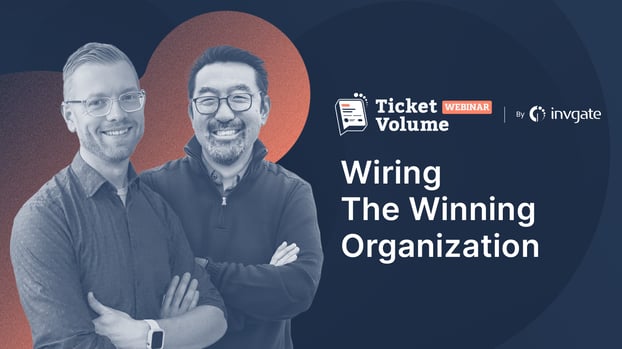There is no standard strategy when it comes to building and leading successful organizations. However, and particularly in tech, there are two big names that inevitably take center stage: innovation and adaptability.
To help with this, Gene Kim, author of "Wiring the Winning Organization," has been studying high-performing technology organizations for many years, collecting a bundle of knowledge on the way.
On April’s Ticket Volume Webinar, the guest speaker explored along with our host, Matt Beran, how winning organizations are wired. To do so, he broke down key concepts presented in his book, including the three main mechanisms to successfully wire organizations: Slowification, Simplification, and Amplification.
Join us as we explore the episode’s highlights! And, don’t forget to register here to receive information on future guests and events.
Let’s get into it.

Download AI prompt templates for service and support pros
Speaking of adapting to evolving environments in tech, prompt engineering to guide AI models is a fundamental skill for IT professionals today.
With this in mind, during the webinar, all attendees were provided a template with prompt examples to guide them through the process. You can download it in the form below!
The power of adaptability
Uncertainty is one of the only constants that we can hold on to today. In this sense, when it comes to wiring winning organizations (and teams, for that matter), prioritizing adaptability takes center stage.
Gene started out the episode by highlighting how the tech community has historically excelled in “continually pushing frontiers of performance,” constantly putting its efforts and wisdom into new projects and technologies and making sure that organizations move forward and improve.
To illustrate this, and taking from his long experience with DevOps, he pointed out that many of those who took on the task of bringing the framework into organizational practices, are now also on the front line of Artificial Intelligence (AI).
Key concepts to wire the winning organization
To continue, the guest speaker broke down for the audience the key concepts of his recent best-selling book, "Wiring the Winning Organization."
To explain the origin, he shared the two main questions that guided his work when investigating different organizations and how they deliver value: Why do organizations work the way they do (both in the ideal and not ideal) and what do all frameworks have in common.
In essence, he answered, all frameworks and best practices are incomplete expressions of a far greater, and at the same time simpler, hole. And, in this sense, this shortage can be understood through the three main mechanisms: Slowification, Simplification, and Amplification.
Let’s take a look at them in more detail.
Slowification, Simplification, Amplification
How do people come together to solve problems efficiently and effectively? Gene made the argument that there are three mechanisms that successful organizations adopt to drive high performance.
Plus, all processes are fundamentally focused on driving adaptability and empowering teams to thrive instead of restraining their areas of work.
The three mechanisms to wire a winning organization are:
- Slowification: Makes solving problems easier by focusing on slowing down and creating space and time to move complicated work from production into planning and practice.
- Simplification: Makes problems themselves easier to solve in order to partition problems so that they are easier to solve. This includes activities such as modularization, linearization, and designing the handoffs.
- Amplification: Makes it visible that certain problems must demand attention. It looks to create a system that takes the weakest signals of failure to detect them, correct them, and ideally prevent them.
"These mechanisms are all the things you need to create systems that fully liberate people’s full creativity and problem solving capabilities as opposed to systems that somehow put everyone in little boxes and constrain them or maybe even extinguish them entirely."
Gene Kim
Wall Street Journal bestselling author
Live Session of Ticket Volume
What is social circuitry?
Another key concept of the book brought up by the guest, is social circuitry. To explain this, Gene presented the following layers that organize the workplace.
- Layer 1: The object in front of us, which can be the studio, the code, the ticket.
- Layer 2: Tools and technologies adopted.
- Layer 3: Organizational routines, habits, norms, and habits.
The third layer contains the social circuity and it is where all the organizational wiring has to put its best efforts into making it successful. Based on this, the three mechanisms introduced previously operate within this layer.
So, when your third layer is wired correctly, this means that all your team's efforts, potential, and creativity can be put into solving problems and operating efficiently. On the other hand, when they have to put too much time into compensating for social circuitry problems, they are put off from creating the value that your organization needs.
|
|
"Whenever you see these great ‘worst to first’ stories (...), what’s amazing is that they are all done with the same people, same capital equipment, same floor space, same data center, same underlying technologies. So, it means that the only thing that changed is layer three, nothing changed in layer one and two. It just shows how leaders are responsible for creating that." Gene Kim |
Mental health
Finally, another important point touched upon during the webinar when it comes to wiring winning organizations is the importance of prioritizing mental health.
Gene argued that it’s important to understand that this is not just a current trend, but, quite on the contrary, employee wellbeing shouldn’t be overstated when it comes to leading high performing teams.
For Gene, mental health sets the stage for high performance, as everything else is secondary to it. It is a central function of leaders in charge of wiring organizations who are responsible for setting out the conditions for people to work.
On this matter, earlier this month, Christopher Dancy came on the podcast to discuss the Future of the Workplace, and reflected upon fears, uncertainties, and mental health in work environments.
To sum up
Gene Kim has been studying high-performing technology organizations for the past 25 years.
So, it’s fair to say that he knows a thing or two about what works and what doesn't when it comes to wiring winning organizations.
Here we explored the main points argued during the webinar. But there’s much more where this came from that you don’t want to miss. Listen to the full recording on Apple Podcasts, Spotify, YouTube, or your favorite podcast platform.















